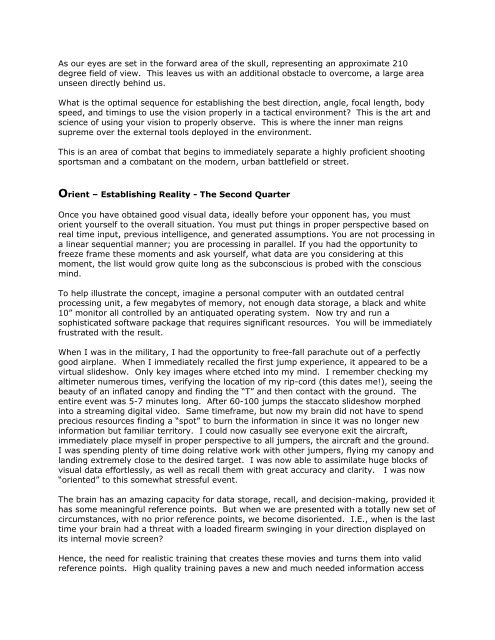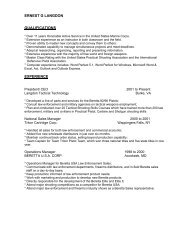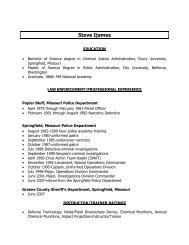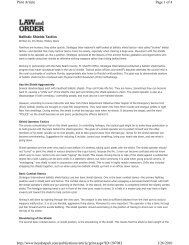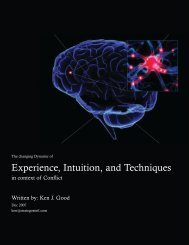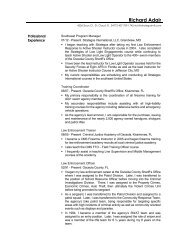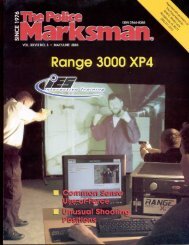Got a Second? - Strategos International
Got a Second? - Strategos International
Got a Second? - Strategos International
Create successful ePaper yourself
Turn your PDF publications into a flip-book with our unique Google optimized e-Paper software.
As our eyes are set in the forward area of the skull, representing an approximate 210<br />
degree field of view. This leaves us with an additional obstacle to overcome, a large area<br />
unseen directly behind us.<br />
What is the optimal sequence for establishing the best direction, angle, focal length, body<br />
speed, and timings to use the vision properly in a tactical environment This is the art and<br />
science of using your vision to properly observe. This is where the inner man reigns<br />
supreme over the external tools deployed in the environment.<br />
This is an area of combat that begins to immediately separate a highly proficient shooting<br />
sportsman and a combatant on the modern, urban battlefield or street.<br />
Orient – Establishing Reality - The <strong>Second</strong> Quarter<br />
Once you have obtained good visual data, ideally before your opponent has, you must<br />
orient yourself to the overall situation. You must put things in proper perspective based on<br />
real time input, previous intelligence, and generated assumptions. You are not processing in<br />
a linear sequential manner; you are processing in parallel. If you had the opportunity to<br />
freeze frame these moments and ask yourself, what data are you considering at this<br />
moment, the list would grow quite long as the subconscious is probed with the conscious<br />
mind.<br />
To help illustrate the concept, imagine a personal computer with an outdated central<br />
processing unit, a few megabytes of memory, not enough data storage, a black and white<br />
10” monitor all controlled by an antiquated operating system. Now try and run a<br />
sophisticated software package that requires significant resources. You will be immediately<br />
frustrated with the result.<br />
When I was in the military, I had the opportunity to free-fall parachute out of a perfectly<br />
good airplane. When I immediately recalled the first jump experience, it appeared to be a<br />
virtual slideshow. Only key images where etched into my mind. I remember checking my<br />
altimeter numerous times, verifying the location of my rip-cord (this dates me!), seeing the<br />
beauty of an inflated canopy and finding the “T” and then contact with the ground. The<br />
entire event was 5-7 minutes long. After 60-100 jumps the staccato slideshow morphed<br />
into a streaming digital video. Same timeframe, but now my brain did not have to spend<br />
precious resources finding a “spot” to burn the information in since it was no longer new<br />
information but familiar territory. I could now casually see everyone exit the aircraft,<br />
immediately place myself in proper perspective to all jumpers, the aircraft and the ground.<br />
I was spending plenty of time doing relative work with other jumpers, flying my canopy and<br />
landing extremely close to the desired target. I was now able to assimilate huge blocks of<br />
visual data effortlessly, as well as recall them with great accuracy and clarity. I was now<br />
“oriented” to this somewhat stressful event.<br />
The brain has an amazing capacity for data storage, recall, and decision-making, provided it<br />
has some meaningful reference points. But when we are presented with a totally new set of<br />
circumstances, with no prior reference points, we become disoriented. I.E., when is the last<br />
time your brain had a threat with a loaded firearm swinging in your direction displayed on<br />
its internal movie screen<br />
Hence, the need for realistic training that creates these movies and turns them into valid<br />
reference points. High quality training paves a new and much needed information access


